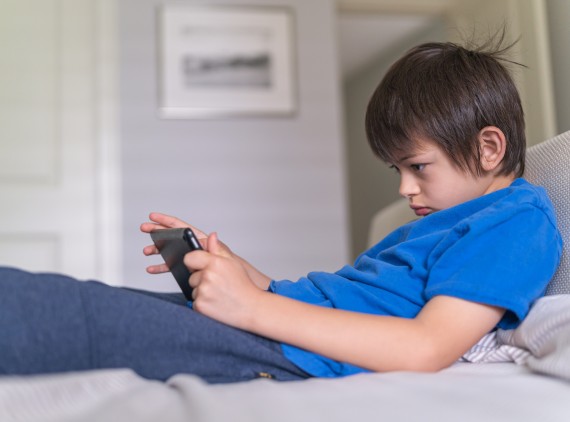The COVID-19 pandemic has certainly brought families many new challenges, including controlling the amount of screen time their children receive. It is not unheard of for our children to now get 8 hours a day of screen time through a combination of virtual school, online video meetings with friends and their usual dose of entertainment related screen time (social media, video games, TV, etc.). While much has been discussed about the specific number of hours of screen time children are receiving, it is also worthwhile to discuss the toll it may take on our children’s eyes and posture.
Normally, during the course of the day, we look at objects at varying distances for varying amounts of time. During prolonged screen time, with virtual school for example, we are asking the lenses of our eyes to focus on a single object (the computer screen) at an unvarying distance for an extended period of time. In addition, improper lighting, computer screen glare, infrequent blinking and poor positioning can all lead to eye fatigue or strain, also known as asthenopia. When this occurs, symptoms such as eye discomfort, irritation, blurred vision, and headache can result - even in children.
Here are simple fixes and adjustments parents can do to help prevent strain and ease concerns, ensuring a more comfortable experience for their children.
- The 20-20-20 rule. The American Academy of Ophthalmology recommends that both parents and children alike should remember to take a screen time break every 20 minutes and look at something 20 feet away for 20 seconds. This allows the lenses of the eyes to relax and ease its strain.
- Proper screen placement. Staring at a screen that is placed too high up in one’s field of vision, often the case when a child is using a computer at an adult’s desk, causes the upper lids to open wider. This causes eyes to dry out more quickly. Parents should raise the seat height or lower the computer screen to ensure that the screen is at or slightly below their child’s eye level.
- The 1-2-10 rule. Parents should also make sure the screen is at the proper distance from the child’s eyes. Smart phones should be placed one foot from the eyes, desktop and laptops at two feet and TVs at 10 feet. Screens at these distances will help to reduce eye strain.
- Adjust lighting and screen brightness. Eyes can also strain when looking at a computer screen that is brighter than the surroundings. Parents should decrease the screen’s brightness so that it matches the surrounding environment. Glare on the screen makes the eyes work harder as well. To reduce glare, ensure that the light sources in the room, including light from a nearby window, aren’t shining directly on the screen.
Unfortunately, eyes may not be the only recipients of strain during prolonged screen time - a child’s back can also be negatively affected. Poor posture habits, like being slumped over in front of a screen for hours, leads to muscle strain and tension in the back and neck.
Below are some tips for parents to ensure their children maintain a neutral posture, avoiding extra strain on the back.
- Desktop or laptop positioning. A screen that is not placed at eye level promotes a child to use bad posture in order to see the screen. This is especially true with laptop use, which often causes children to hunch over the keyboard to view the screen. If possible, have a child use a desktop computer as they are more easily adjustable to the child’s field of vision. If a laptop is the only option, use books to raise the screen to eye level.
- Be aware of child’s posture. A child’s spine should be straight and in a neutral position. Parents should watch for hunching, twisting, or arching of the spine. This also includes the spine in the neck, try to watch for head and chin slumping down as well.
- Have a designated workstation. Discourage computer use while on the couch, bed, beanbag chairs or on the floor as they also encourage poor posture. Instead, have a designated workstation with an adjustable chair. For smaller children, parents may need to use blankets or pillows on their seat to raise their field of vision.
- Chair height and positioning. For improved alignment, chair height should be adjusted so the child’s feet can rest flat on the floor. Parents can also use a step stool so the feet are supported. Additionally, wrists should not be resting on the keyboard while typing. A remote keyboard is a great investment that prevents wrist strain.
- Hit the posture reset button. It’s important to take frequent breaks in the day from sitting. In between classes, have children get up and stretch or go outside for a short walk or playtime. Setting a timer every hour to remind everyone to take a few minutes to stretch can also be helpful.
While it may be not ideal, our children’s increased screen time has allowed many children to continue regular schooling and connect with friends and family. Additionally, most of the eye and back strains are not permeant if early corrective measures are taken. If children continue to complain of eye or back strain, it’s time to schedule a visit at Phoenix Children’s Hospital where we can help evaluate and treat your child. Hopefully, the above tips can take some of the strain out of prolonged time at the computer.

